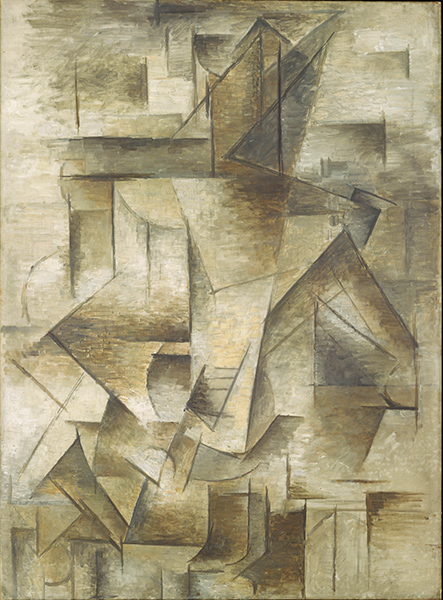Literary Techniques and Cubist Analytical Art
In Der Weg zum Kubismus, Kahnweiler explains the so-called “distortions” by “the unity of the work of art”, by “the yielding of the parts to the rhythm of the whole.”[1]. At the beginning of the so-called “experimental period ” (1911), Gertrude Stein developed literary techniques alongside the ones Picasso was developing in analytical cubist art. Semantic consistency and referentiality were replaced by “the primacy of surface” and “the ascendancy of the signifier,” with meaning ranging from “conventional coherence” to “utter unintelligibility.” Picasso's analytical art[2] was also dismissed as “incoherent,” as were Max Jacob's cubist poems.[3] In keeping with Marianne DeKoven's considerations, the term “unintelligible” seems more justifiable than “incoherent,” since “unintelligible” suggests a complete absence of a legible ILISIBLE?@ meaning, whereas “incoherent” refers to the presence of a legible meaning.[4] Picasso never wished to plunge his works into an abstract world. In his urge to reappropriate the object and reality, he quickly turned away from cryptic and analytical writing, integrating easily identifiable fragments of reality in his synthetic stage.
Much like Gertrude Stein's experimental writing, the analytical paintings are incoherent, insofar as they elude the usual logical order. However, meaning is present, although in a multiplied, fragmented, non-thematic way. In terms of synax, the visual statement and the written statement could be based on what Noam Chomsky refers to as “degrees of grammaticalness.” The dialectical opposition of the two forms of expression with the Chomskian model is useful for examining their analogical relationship: “while it retains ‘readable’ shapes–bits of a face, a hand, a table, a violin–it fragments them, multiplies them, flattens them toward the surface of the canvas, makes them incoherent.”[5]
The fact of not subjecting perception to a spatial boundary by focusing the viewer's attention on any given point of reference offers the subject a potentially analogical identification with the object, which unfolds freely within duration.
That is why Kahnweiler compared the analytical paintings with writing. Analogous, in this sense, to Gertrude Stein's poems, they had to be “read.” For Bergson, to read is to reencounter. To reencounter, to reinvent the rhythm of the composition. But, given their characteristic syntactical incoherence and morphological and functional ambiguity, how are they to be read? Ultimately, do they not require a stratigraphic reading? The fundamental paradox of the analytical figure lies in the possibility of coexistence of what Merleau-Ponty refers to as visibilia incompossibles, in other words, incompossible views that are nonetheless capable of coexisting with each other. This coexistence, which defines cubist space, is not unrelated to time. Since understanding is above all a temporal process in which the immediate sense of movement anticipates comprehension of the work itself, one conceives that this anticipation (which is the reversed double of the retrospection of the possible) takes on the form of a rhythm. Associating the idea of depth with the idea of simultaneity, Picasso designates the alliance of temporality with spatiality.
[1] In the introduction to the French version, written 1914-1915, Kahnweiler highlights certain issues such as the conflict between the unity of the painting and the multiplicity of the outside world which it aims to capture. In order to safeguard the fundamental internal unity and thus work multiplicity into that unity, Picasso resorts to means such as distortion. Cf. Daniel-Henri Kahnweiler, La montée du cubisme (1914-1915; published in English as The Rise of Cubism), in Confessions Esthétiques, Gallimard, Paris 1963.
[2] Cf. Albert Fournier, Demeures du temps retrouvé, Éditions françaises réunies, Paris 1971 p. 304.
[3] Max Jacob, Art poétique, 1922, Éditions Emile-Paul frères, Paris, p. 64.
[4] Marianne DeKoven, “Gertrude Stein and Modern Painting: Beyond Literary Cubism”, in Contemporary Literature, vol. 22, issue 1, (pp. 81-95), winter 1981, pp. 82-84.
[5] Winthrup Judkins, “Toward a Reinterpretation of Cubism”, in Art Bulletin, December 30, 1948, pp. 275-76.





 Summary
Summary